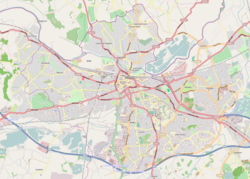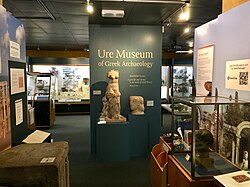 Entrance of the museum | |
Former name | Museum of Greek Archaeology |
|---|---|
| Established | 1922 |
| Location | Reading, Berkshire, United Kingdom |
| Coordinates | 51°26′29″N0°56′44″W / 51.441272°N 0.945522°W |
| Type | University museum |
| Curator | Amy C. Smith |
| Website | collections |
The Ure Museum of Greek Archaeology is a museum of ancient Mediterranean archaeology, primarily that of ancient Greek civilisation but with smaller collections of Egyptian, Etruscan and Roman items. It contains one of the most important collections of ancient Greek pottery in the United Kingdom. The museum is part of the University of Reading's University Museums and Special Collections Services (UMASCS), and is located in and works closely with the university's Department of Classics. The museum is situated on the university's Whiteknights Campus, about 2 miles (3.2 km) from the centre of the English town of Reading, Berkshire. [1] The museum is open to the public and entry is free. [2]



